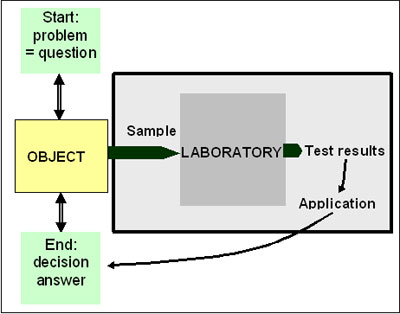There is more than the analytical technique only
Jo Klaessens, StatAlike, The NetherlandsAbstract There is more to the analytical discipline than the contents and details of the analytical techniques only. In order to set these fine pieces of technology to work, they have to be embedded in the logistics and work routines of a laboratory. Furthermore, there must be an economical necessity to create added value with the analytical results. The customer set the limits of time, cost, the desired accuracy. Quality standards have to be met. This contribution deals with these aspects of the analytical process.
LevelBasic
The laboratory from the user’s perspective
The laboratory is not an isolated entity, nor can it be considered in isolation. It is always a part of a decision making process at a higher level: the laboratory produces the analytical results required by the user in order to make a decision or to solve a problem.
The user – the customer - has a question or a problem. In order to get an answer or make a decision, he needs information. The information is provided by the laboratory on the basis of samples taken from the object under investigation. To the user, a laboratory is a black box in his decision making process.
The laboratory supports the customer's decision making process
The black box
The laboratory in the eyes of the customer is a cost centre that should create additional value for his business process (e.g. a production process). For the customer the laboratory should only meet the constraints set by his core process. From this perspective, the analytical technique itself is of secondary interest. The complete set of application objectives determines the best solution, while what is 'best' from an analytical point of view may very well be sub-optimal if all requirements are considered.
The objectives of the user determine:
- The time constraints: how much time does the laboratory have after sample reception until the report should be sent out;
- The costs involved: how much is the user willing to pay for the analytical information. In other words: how much value is involved in the user’s decision making process and to what extent is analytical information needed for this purpose?
- Type of analysis: quantitative vs. qualitative.
- Accuracy of the analysis in terms of detection limit, reproducibility and trueness.
The laboratory from the user's perspective: a black box
To some extent the quantitative/qualitative and accuracy issues are money related as well. Qualitative analysis is generally cheaper than quantitative. Improved accuracy tends to increase the costs involved.
The position of a laboratory within an institution or company is not significantly different from a commercial laboratory. One difference is that the relation is weaker: the laboratory has many customers/users and it is less clear to the laboratory for what purposes the analytical information is going to be used.






